Yesterday morning I learned something about hummingbirds. Maybe I’ll start trying to get hummingbird takeoff shots again. It’s been a while.
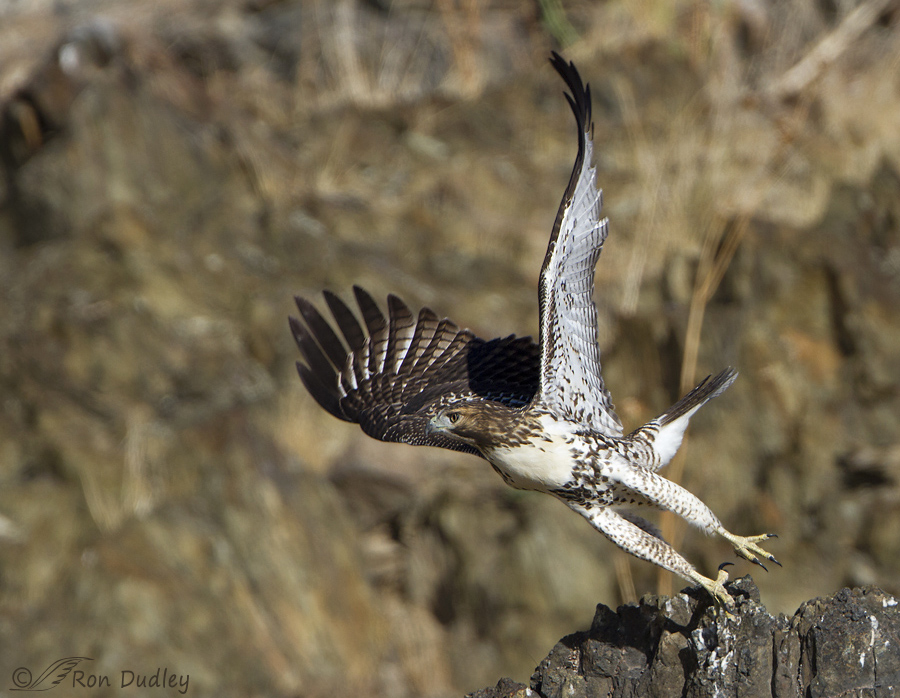
Now this is what I call a takeoff shot.
The Red-tailed Hawk is putting some real effort into becoming airborne. It’s reaching with its entire body in the direction it’s taking off, it’s pushing off mightily with its legs and it’s actually looking in the direction it intends to fly.
This is a type of dynamic takeoff shot that I think most viewers find interesting, even fascinating. Takeoff postures like this are in part a function of size but only in part. For complicated reasons related to physics, inertia and aerodynamics large, heavy birds tend to have more difficulty becoming airborne so they really have to work at it and as a result their takeoffs tend to be visually interesting.
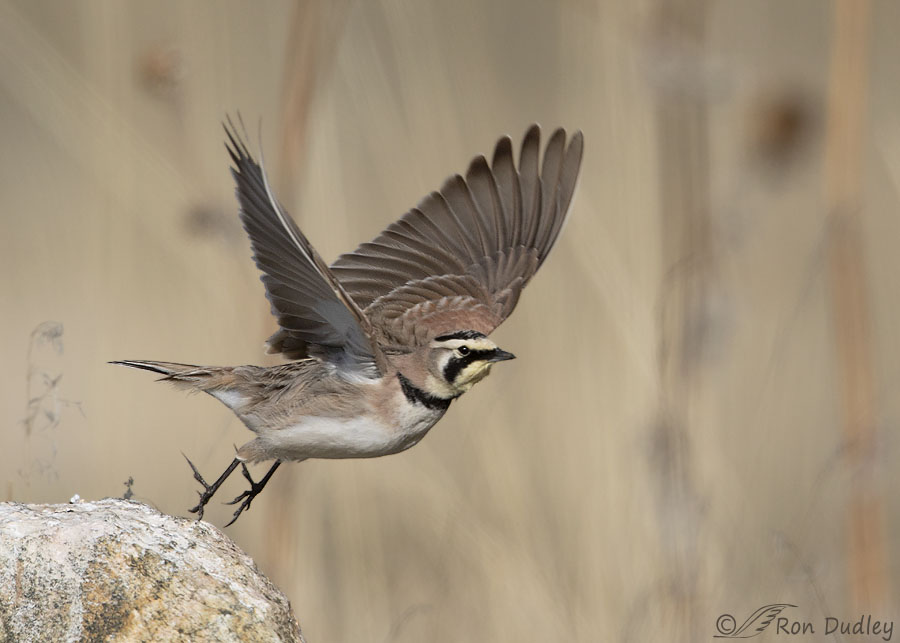
To a lesser degree songbirds like this Horned Lark have to work hard at gaining flight so they have interesting takeoffs too.
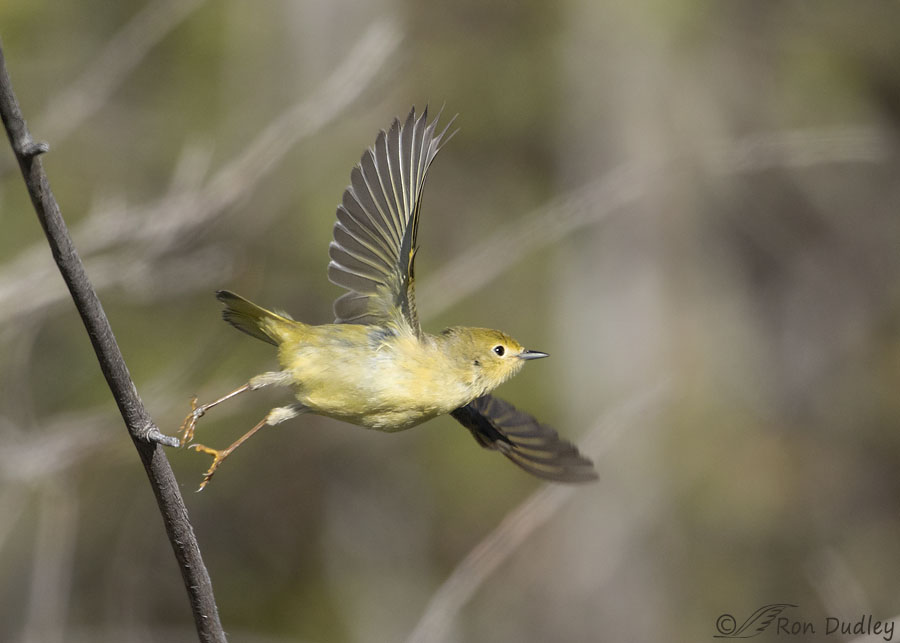
So do smaller songbirds like this Yellow Warbler.
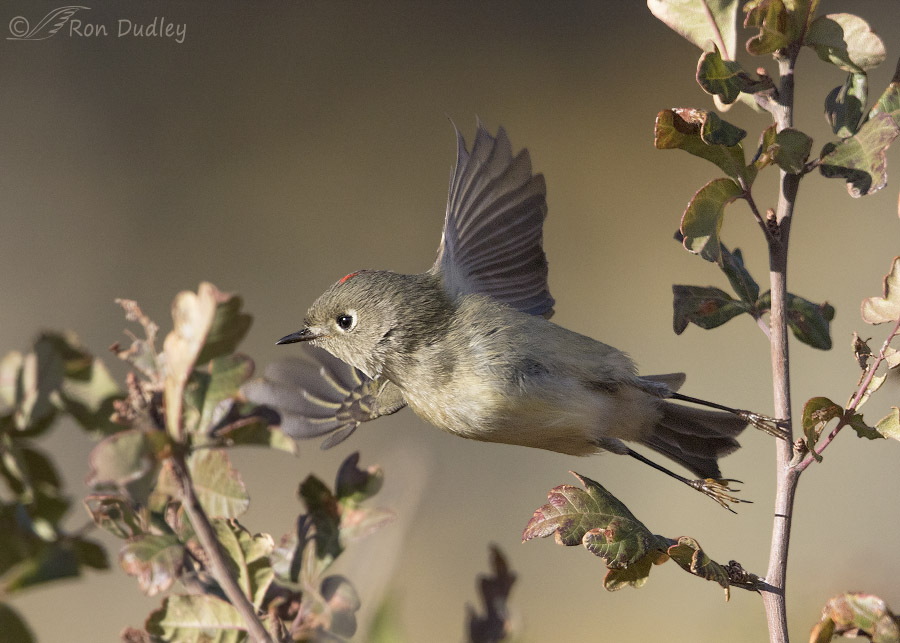
Even the smallest of songbirds like this Ruby-crowned KInglet often push off with their legs as part of a dynamic takeoff.
But hummingbirds are an exception. When they take off they generally look like they’re putting little to no effort into it. Their wings begin to whir and they simply lift off from their perch as if a mechanical crane or an invisible catapult has launched them into the air. Only their wings seem to be doing any work – the rest of their body just hangs from them and enjoys the ride. They don’t seem to push off with their legs or reach in the direction of takeoff with their body.
There are three reasons that I’m aware of that explain why hummingbird takeoffs are less interesting visually:
- They have so little mass (weight) acceleration takes relatively little work.
- Their wings are incredibly fast and efficient so the rest of their body doesn’t have to contribute much to takeoff
- Their stubby little legs are so short pushing off with them wouldn’t contribute much to lift or acceleration anyway
As a result I gave up making extra effort to photograph them at takeoff years ago because hummer takeoff shots tend to look like any other hummer flight shot – they’re just closer to their recent perch than usual. Hell, I don’t even have an older example of a hummer takeoff shot to include here to document my claim. I just don’t take them, unless by accident.
But yesterday in the mountains I accidentally photographed a Broad-tailed Hummingbird at takeoff that has me rethinking my position.
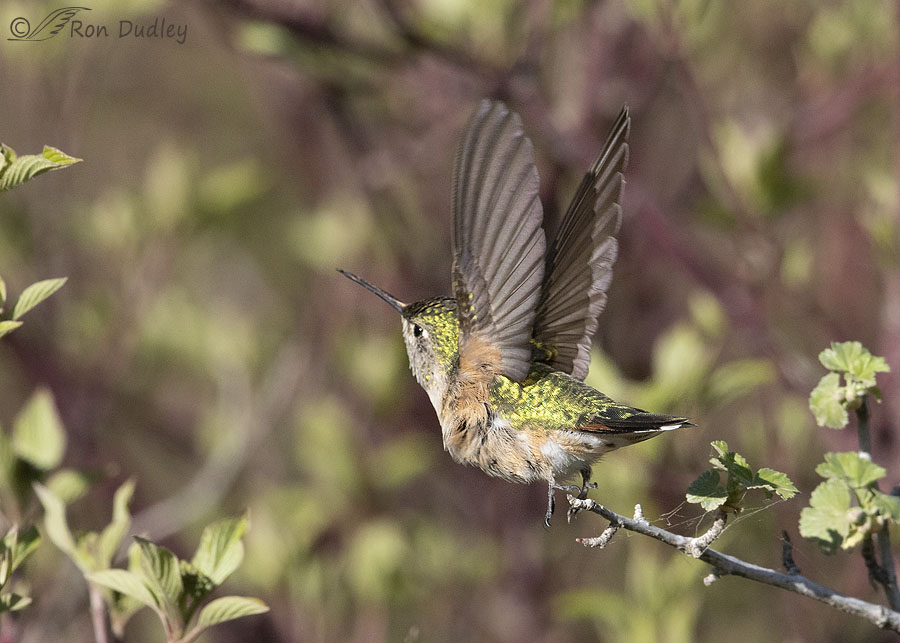
1/5000, f/6.3, ISO 1250, Canon 7D Mark II, Canon EF 500mm f/4L IS II USM + EF 1.4 III Extender, not baited, set up or called in
It isn’t a very good shot because she took off away from me and she’s a little soft.
But this is the first time I remember photographing a hummer at takeoff where the bird actually looked like it was putting some effort into it, other than its wings. She’s pushing off as best she can with her stubby little legs, her body appears to be straining in the direction of takeoff and she’s even looking in that direction instead of somewhere else.
If I had a 90° shooting angle on her or I was shooting from slightly in front of her I think this could have been a pretty interesting takeoff shot, at least for a hummingbird. They probably do this more often than I think they do, I just haven’t been paying attention.
So yes, I learned something about hummingbirds yesterday and now I may try more often to get them at takeoff.
For many of my readers all this is much ado about nothing I’m sure. Bird photographers addicted to takeoff shots are about the only folks who would care about such things.
But I am so I do.
Ron


As much as I loved your photos of the Big Birds taking off, your description of your assumptions about the hummingbird and the subsequent debunking were fascinating!
Man, this post got a bunch of great responses. All I can say is your story has legs.
It does, thanks to my readers.
As soon as the confinement ends I’ll try it. The highest for me was ISO 1000.
Thank you.
Mine didn’t turn out too bad, given the ISO. You don’t want to crop them much though…
A beautiful takeoff of each picture. I wish my takeoffs of getting off the couch these days looked that graceful

I’ve never seen an Osprey takeoff in person but their ability to hover is so fascinating to me.
Enjoy the rest of your day
” wish my takeoffs of getting off the couch these days looked that graceful”
Me too, Diana. With my bad back…. well, you can imagine.
As always I am fascinated, intrigued and awed.
You and your commentators start my day off well.
It is not quite four in the morning here and I have seen beauty, I have learned things, and I have connected with kindred souls….
And how I envy your photo library. To be able to go through and select take off shots from a variety of birds just blows me away. Again.
“To be able to go through and select take off shots from a variety of birds just blows me away”
Thanks for appreciating that, EC. The saving grace is having a system, complicated though it can be at times, that allows me to actually find the specific type of shot I’m looking for to illustrate my point. Especially considering how many photos I have.
Of course I appreciate it. Big time.
Superb takeoff shots, each and every one! I like the hummingbird angle, personally, because my eye is really drawn in her forward direction.
So much excitement for one morning! I’m drawn to the ratios — body length:wingspan:leg length — between the different species you have represented here. Adaptations are fascinating!
“Adaptations are fascinating”
Aren’t they! You and I have a similar intense interest in them, Marty.
Well, no matter whether she’s using her legs to lift-off or not in this picture — Dan pretty much dispels that notion — I still would swear I can see and hear a little grunt from her as she revs up to go! It’s a great little action shot, even if it’s not a Red-tail take-off (which is matchless). Beautiful little hummer.
Chris, next time I have the opportunity I’ll have to listen for that grunt…
Neat capture. In my experience I would say they push off with their legs. If I have an opportunity I will try to pay more attention and perhaps video it.
I’ll be paying more attention too, April.
A great series of photos. In the case of the hummingbird, I suspect that you caught it at the moment the legs were being pulled up against the body and that the legs are not really doing much work at all. Even very large hummingbirds (the Giant Hummingbird in the Andes is about the size of a Song Sparrow) simply seem to lift off as you see in our smaller hummingbirds. Flight is a very complex series of events. Simply moving the wings up and down accomplishes nothing. To get lift, the wing must be moved forward and down. It is the hand portion of the wing (from the wrist outward) that does most of this work and that’s especially important in takeoff when the angle of attack is steep, generating more lift. No lift is created by the upstroke of most birds and that push forward helps keep forward movement until the next power stroke dowm. For hummingbirds, nearly the entire wing is the hand. The inner wing is very short and the wrist is near the body. This means that lift is being generated with each stroke. Further, the wing is turned over at the end of the downstroke so that the “upstroke” also generates lift instead of folding and allowing airt to pass through as in other birds (All too complex to fully explain here.) The result is a figure-8 pattern instead of down and forward, then up and back as in other birds. Hummingbirds don’t glide. Every stroke is a power stroke creating lift. So with the first wing cycle, forward and back, there is lift and little need to gain forward momentum by pushing with the legs. I’m not sure I’ve been entirely clear in a short space. The textbook I am writing devotes an entire chapter just to explaining flight. Hummingbirds are truly amazing creature in all respects.
Oops. Why do I only discover error after I push post? I said “No lift is generated by the downstroke…” That should say “upstroke.” It is the downstroke where lift is generated. Serios typo on my part. Brain and hand don’t always seem to stay connected.
Dan (and others) – I’ll fix your unintentional error so there’s no confusion.
Fascinating — never knew how different hummingbird wing anatomy is from other birds. I always appreciate you sharing your vast knowledge with us. Looking forward to the textbook!
BTW, I had to go back up and re-read that sentence — my brain automatically changed it to “upstroke” for me, so I didn’t even notice the error.
Thanks very much, Dan. Fascinating and enlightening information as always.
I have a question. So in hummingbirds is there demonstrably no lift at all provided by the (presumed) airfoil shape of the hummingbird’s wing when the bird is moving swiftly forward through the air, as in other birds?
Perhaps not because the wing is moving in a figure 8 pattern, but I figured I should ask rather than presume.
Hi Ron, Sorry for a late reply. I’ve been out most of the day with appointments.
In hummingbirds every wing beat, forward and back, creates lift. Think of a bird’s wing in two parts. The inner wing, from body to wrist is a “stationary” fixed wing like that of an airplane. The outer wing (manus, or hand) provides the power like the propellers of an aircraft. Once in flight, the inner wing provides lift because of its airfoil shape and the fact that as it moves through the air the change in air pressure above and below the wing creates lift. Without movement, no lift is generated. An albatross has very long, slender wings providing a large surface to generate lifT (without drag generated over a broad wing). In still air they must run to get enough air movement over the wing for lift or they point into a strong wing to get enough air movement over the wing for lift. That airfoil shape, as air moves across it, causes less pressure above the wing, thus lift is created To demonstrate this pressure change effect, hold a sheet of paper up to your lower lip and blow over the top of the paper, not on the underside. Displacing that air away from the paper’s top decreases the pressure and the paper rises. In hummingbirds, there is no inner wing (not enough to function as an airfoil) and the movement of the wing generates lift as a power stroke in each direction. With no lift from an inner wing the hummingbird must keep its wings moving forward and back to stay airborne. As the wing turns over at the end of each stroke, the primaries stay together instead of creating open slits to allow the air to come through to more easily raise the wing as in most birds. By having no slits between feathers an airfoil is created in each direction the wing moves and lift is constantly generated as long as the wings are beating.
Excellent explanation, Dan. Thanks very much. You’re a champ!
LOTS of info there – think my brain just wants to “look” for the moment!


Very interesting subject. I never thought about it.
Thank you for bringing it up.
On a side note and looking at your settings (ISO1250) do you remember what was the higher value you have ever used with the 7D Mark II?
Jorge, If I remember correctly the highest ISO I’ve ever used with a 7DII was ISO 2000 while photographing Sage Grouse on a lek before dawn.
Don’t you just love learning something new? I know I do! I try to collect at least one new thing into my noggin every day, stuffing it into all the other stuff in there. LOL!!
Personally, I love watching takeoffs and seeing that little slice of suspended time in your photography is a real treat since my eyes just don’t work that fast–a case of our substandard equipment! I’ve also found it simply amazing that one could jump into thin air, making the outrageous assumption that wings would keep you from making that SPLAT sound soon after, in effect thumbing (winging) that gravity reality that sticks us to the ground! And that’s yet another example of our substandard equipment. But the sheer hubris of that action As I’ve mentioned before, I want wings–REAL raptor wings–if that reincarnation thing turns out to be a thing!
And thank you again for beginning this discussion with a lovely redtail! What a wonderful way to begin the day!!
Laura, why do I nearly always think of you when I post a red-tail?
I am sooooo with you on the wings thing. And also on the substandard equiptment. And go splat more often than I care to think about.
The hummers are becoming more numerous at my feeder and I love them. I’ve never paid attention to their takeoff. I’ll try to be more attentive. It is so fast I may never see any difference. Great pictures and the lessons you present are great as well.
Betty, I still haven’t seen any at my feeder but my neighbor saw her first one at her feeder late yesterday afternoon.
Moral of the story is…we’ve all gotta push ourselves to get started.
Interesting – something I’ve never thought about! Don’t know how much push off a hummer would get with those stubby little legs BUT! Guess I don’t think about them really taking off in a forward direction……. Always something new to learn/consider…
Don’t know how much push off a hummer would get with those stubby little legs BUT! Guess I don’t think about them really taking off in a forward direction……. Always something new to learn/consider… 
Judy, I don’t think they’d get much push at all, but it seems like they might get some. Every little bit helps.
Outstanding take-offs, but the Red-tail takes first prize. Will have to look through my hundreds of hummer photos to see if I even have a take-off. Your take-off analysis got me thinking of my eagle take-offs. Now that I think of it about 90% of them are in a downward angle and that would probably lessen the amount of thrust needed. Of course most eagle photos are of them high up in trees and when they do take-off where they are aiming to go is below them. From a dead stop on the ground it must take an enormous effort to become airborne. Great photos all.
You make a good point, Everett. The difference in energy requirement for a large bird to take off from the ground versus a takeoff from an elevated perch must be enormous.
All winners !! But I love that Red Tails take off !!!
Thanks, Gary.
Excellent!! I will say you are a pro…getting take-off shots as often as you do that are great is quite an accomplishment..even if you add ‘soft’ to the picture(your word not mine). You actually get what you want. Mine are ‘ by chance ‘. The larger birds are so much easier. Those little warblers…not so much! I have sooo many branch pictures.
Kathy, the general rule is the smaller the bird the faster they are at almost everything, including takeoff. The little guys are tough!
Yes, I thought they just lifted off like a helicopter. So this is a real breakthrough. Neat, Ron!
Nancy, I doubt it’s a breakthrough but it’s new to me, probably because I was making unwarranted assumptions and didn’t pay enough attention.